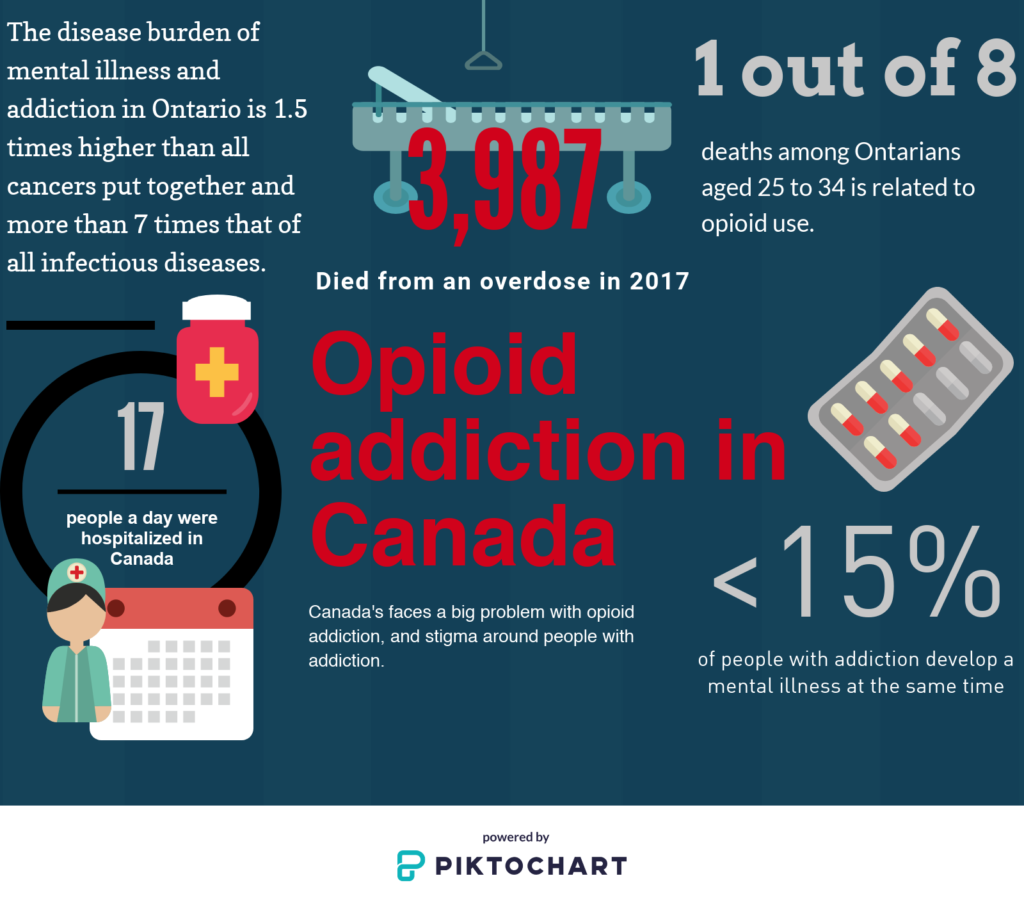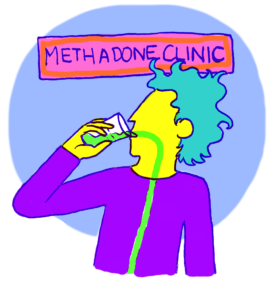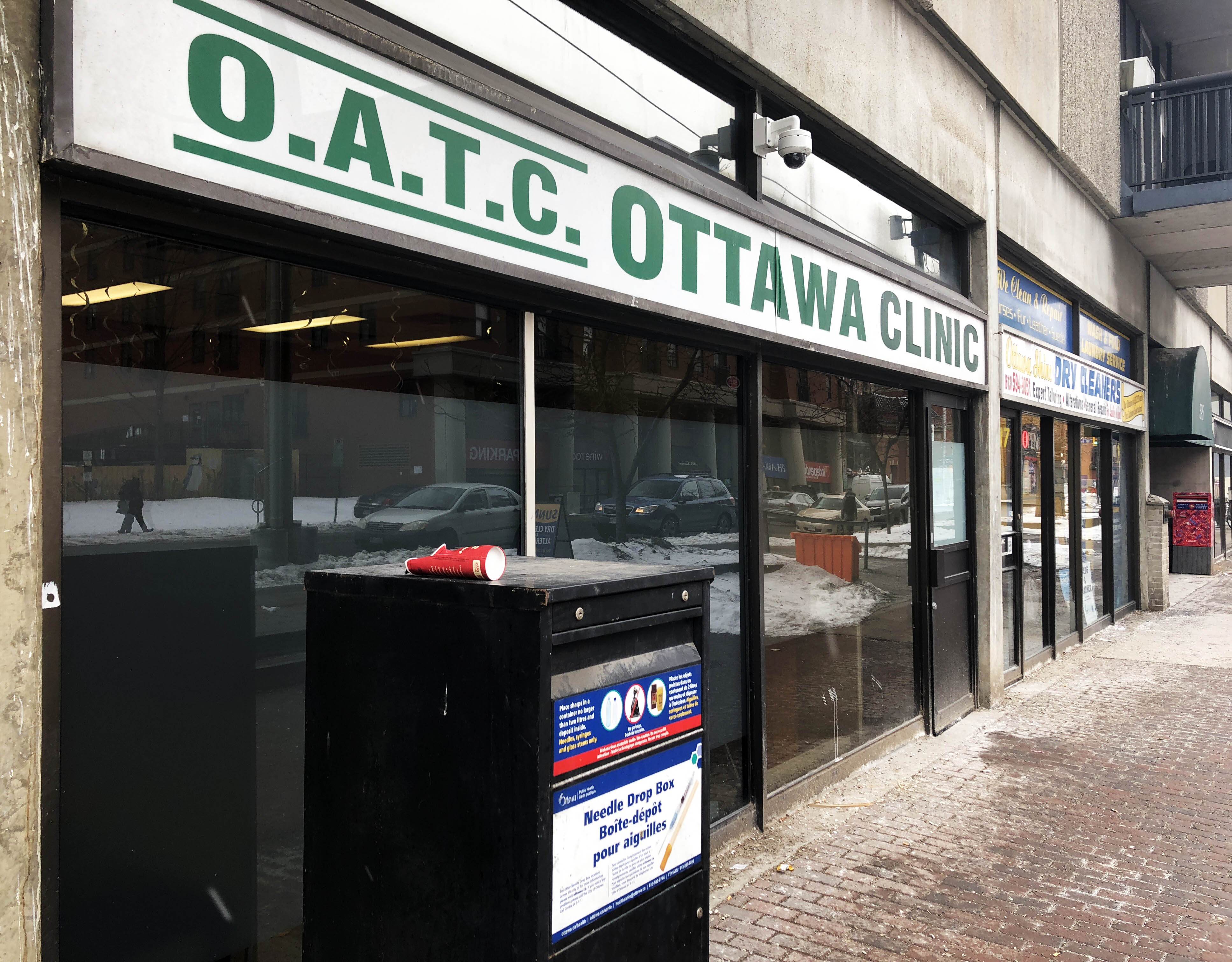Natasha Bulowski looks into the pervasiveness of stigma around addiction, and how it can effect survivors even after they have completed their recovery.
“Here in Ottawa, there is a separate door for methadone patients. You’re not allowed to come through the front door anymore if you want to get your methadone. You have to go to the back,” said Sonya Lockyer, CEO of Canadian Addiction Treatment Centres.

At community pharmacies throughout Ottawa, there are signs that tell methadone patients to enter through the back door.
Methadone is a long-lasting opioid medication used to treat addicts. When dosed correctly, the slow-acting, non-euphoric drug keeps cravings and withdrawal symptoms at bay so addicts can function in their daily lives.
Some say practices like having a backdoor for methadone patients further the stigma around addiction.
“We have to lift that ugly stigma around addiction, because it happens to everybody, even those with the best of intentions,” said Heather Jones, an addictions counsellor with Ontario Addiction Treatment Centre.

“No one wakes up and decides they want to be an addict, and steal, hurt their loved ones or lose their jobs—just like you don’t choose to have cancer or a peanut allergy,” Jones added.
Every Thursday morning, Jones has a standing appointment with Mellissa, an opioid addict. Mellissa has agreed to use her first name, but preferred to remain anonymous.
She is also a mother, a nurse, and a fiancée. Mellissa has been clean for the last seven years, but she said this doesn’t mean she does not still experience stigma.
“There’s just so much negativity and stigma surrounding addiction and people that are on methadone,” she said. “I’ve been clean for years now, yet when I tell somebody I’m a patient at a methadone clinic, they become wary, skeptical, and questioning of my motives.”
“Here in Ottawa, there is a separate door for methadone patients. You’re not allowed to come through the front door anymore if you want to get your methadone. You have to go to the back,” said Sonya Lockyer, CEO of Canadian Addiction Treatment Centres.
Taking methadone helped Mellissa’s recovery.
Like many who become addicted to painkillers, Mellissa was first introduced to opioids for pain relief. She has Crohn’s disease, a chronic condition characterized by intestinal inflammation, which causes severe abdominal pain.
Mellissa was first prescribed Percocet on an as-needed basis to manage the pain. The seemingly harmless pain pills each contained five milligrams of oxycodone.
“It happened without my noticing. I started going to the clinic more frequently. I started paying attention to which doctors would give me Percocet versus Tramadol. I remember thinking to myself ‘Wow, this is crazy.’ You hear about people drug-seeking, and then you begin to do it yourself without even noticing or thinking about it.” – Mellissa, addiction survivor and registered practical nurse
At first, Mellissa only took one Percocet a day, but her addiction escalated rapidly until she needed up to 12 pills daily to avoid withdrawals. When her doctors grew reluctant to prescribe more pills, she turned to the street in search of her next fix.
Here, she made the switch to OxyContin, a painkiller containing the extended-release version of oxycodone.
But unlike her five-milligram Percocets, these little yellow pills came in 40 mg. Over the course of a year, her addiction wreaked havoc on every aspect of her life, as her tolerance increased.
Initially, a single 40-mg OxyContin was enough to keep her “high as a kite” for the whole day, but over time, Mellissa soon found herself needing more and more. At the height of her addiction, she was taking up to six of the 80-mg OxyContin pills each day, simply to keep from entering withdrawal.
“During that year, I had a good job at RBC. Then I got fired. My life just sort of spiraled out of control. I was 25 or 26 at the time. I began working nights as a stripper to make enough money for my pills,” she said. “I lost my job and my apartment, I crashed my car, and was living back at my parent’s house. My life was a mess.”
Mellissa said her addiction soon took over her life.
“Finding my next pill became my entire life,” she said. “I always made sure I saved a little bit for the next morning, but after that line was gone, the first thing I did was start searching for pills.
Getting her next fix became her whole world, Mellissa said.
“Sometimes I’d have a really good night and I’d make more money, so I’d think to myself, ‘OK, I’m going to buy enough for two days,’ but that never, ever worked out. If I had them, I used them.”
worked hard to get into and graduate the nursing program at Algonquin College, a goal that she said, helped keep her grounded as she slowly pieced her life back together.
Mellisa said she doesn’t know where she would be today if her dealer hadn’t stopped selling pills and told her to get on methadone.
On that day, in July 2011, she went to a Vanier addiction clinic to start treatment.
Thanks to a daily dose of methadone, her years spent trying to satisfy an insatiable addiction drew to a close.
“It gave me my life back,” she added. “I didn’t spend my whole days chasing something.”
After 18 months on methadone, Mellissa returned to high school to get her diploma. She graduated at age 27, and applied to nursing school after getting the required science credits. She worked hard to get into and graduate from the nursing program at Algonquin College, a goal that she said helped keep her grounded as she slowly pieced her life back
together.
Now, Mellissa is a registered practical nurse.
However, just because she no longer actively uses does not mean the difficulties of addiction are behind her. Though her cravings for OxyContin are a thing of the past, the stigma around addiction is not.
When health complications landed Mellissa in hospital, she said she was required to disclose her ongoing use of methadone. She said she felt judged by some of the medical staff she encountered.
Mellissa attributes some of the discrimination she faced to a lack of understanding of methadone’s effects on post-operative care. A benefit of the drug is it prevents users from experiencing cravings and withdrawal symptoms, but it also significantly reduces the effectiveness of painkillers, making it vital for methadone patients to disclose their situation to hospital staff for the correct adjustments to be made.
“It’s a catch-22. I’ll tell the doctors that for my pain control after a surgery, you have to increase the dose of my pain medication. Then they look at my chart, and see that I’m an addict, so they question if it’s drug-seeking behaviour, when the reality is that the methadone prevents it from working.”
Despite the importance of confiding in medical staff, Mellissa described an immediate shift in the bedside manner of doctors and nurses when she would disclose her status as an addiction patient.
“It’s their demeanour–it might be an eye roll. They can’t blatantly say anything or they’d get in trouble. But their demeanour changes and when you pull your call bell every four hours for your dose, they think that you just want. You’re less of a priority.” – Mellissa
Pegged as a drug seeker, repeated experiences of this nature eventually led Mellissa to keep her status as a methadone patient a secret during one of her major surgeries. It was a decision that left her suffering excruciating pain upon waking up in the recovery room. Her dose of painkillers had not been properly adjusted.
“I could feel everything,” she said.
Mellissa illustrates how even methadone patients like herself, who are no longer abusing opioids, are still under incredible strain. The stigma not only impacts relationships with family, friends, and employers, but can also prevent addicts from getting compassionate medical care.
Although Mellissa said she is open about her addiction with family and friends, she added that, as a nurse, sharing her history of drug use with her employer does not feel like an option.
“Even though I’ve been clean for years, I still feel like they might not send me to see patients that have narcotics or they might have the next nurse after me do a double count on their patients.
“I just feel like it would negatively affect any future chances for advancement,” Mellissa said. “It’s tricky to navigate. Especially when a patient is talking to me about their struggles with addiction–either present or past–it’s unfortunate that I can’t say I really do understand.”
Jones, who has a strong bond with Mellissa and the other patients she counsels, said she is angry at how addicts are made to feel that they cannot divulge their experiences to others without being instantly stereotyped.
“Here, you have somebody who has struggled, who overcame, who sought out help, who actively engages in counselling on a weekly basis, and has put her life together and done a complete 180,” Jones said. “Why is that something we aren’t going to talk about? She has fought back and has this beautiful life that she has created for herself and that needs to be illustrated and highlighted; that yes, there is light at the end of the tunnel. She’s right here.”
For Mellissa, her Thursday morning visits to the Vanier treatment centre will be a fixture in her life for the foreseeable future, as she continues to take her doses and care for her mental health with the support of fellow patient, Jones.
Lockyer and Jones said that, along with all the Canadian Addiction Treatment Centres’ staff, they share the central goal of creating a stigma-free, supportive environment.
“Our patients are unique—you just need to be able to understand them and relate to their disease,” said Lockyer. “Whatever they need, we want to welcome them back because they’re not welcome in a lot of places in society.”
_________________________________________________________________________________________________________________________________
Image by Natasha Bulowski






